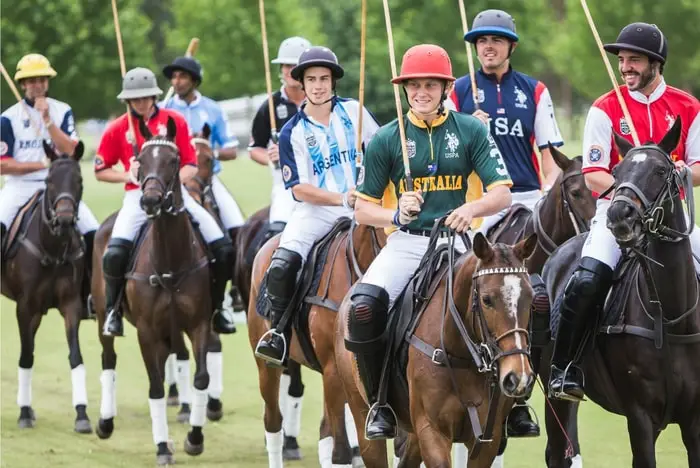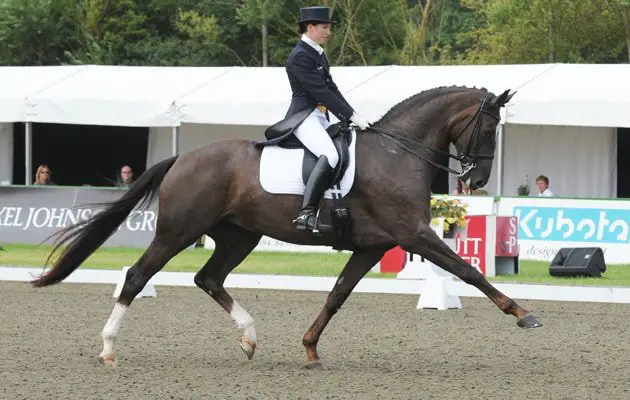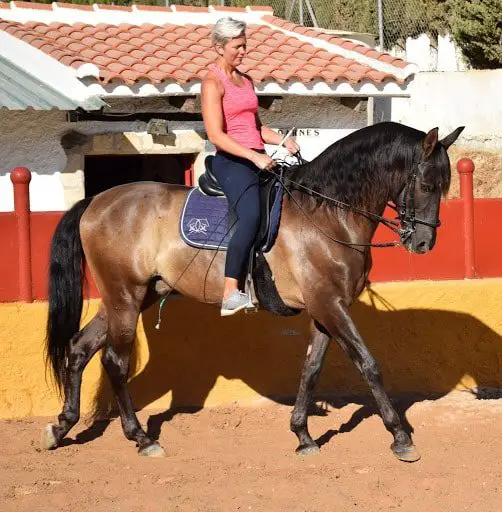A sports horse is a type of horse that is specifically bred, trained, and used for various competitive equestrian sports and activities. These horses are carefully selected and developed to excel in specific disciplines due to their physical attributes, temperament, and training. Sport horses are valued for their athleticism, agility, and ability to perform well in events that require strength, speed, precision, and cooperation with the rider.
What Makes a Horse a Sports Horse?
A horse is considered a sports horse based on factors that make it suitable for and excel in various equestrian and athletic disciplines. While there isn’t a single defining trait that makes a horse a sport horse, several key factors contribute to their classification:
- Athleticism: Sport horses are typically characterized by their physical prowess and natural athletic abilities. They possess strength, speed, agility, and endurance, depending on the discipline they are trained for.
- Conformation: Conformation refers to the horse’s physical structure and how its body is built. Different equestrian sports demand specific conformation traits. For example, show jumpers may benefit from a more uphill build, strong hindquarters, and good balance, while dressage horses require excellent symmetry and balance.
- Temperament: Sport horses should have a trainable and cooperative temperament. They should be willing to work with their riders or handlers, be responsive to cues, and remain calm under pressure. A good temperament is essential for success in training and competition.
- Breed: Different horse breeds are often associated with specific equestrian disciplines due to their historical traits and capabilities. For example, Thoroughbreds are commonly used in horse racing, while Warmblood breeds are famous for show jumping and dressage.
- Training: Sport horses undergo specialized training tailored to their chosen discipline. This training includes teaching specific movements, techniques, and behaviors required for success in competitions. The level of training and the horse’s responsiveness to it play a significant role in determining its status as a sports horse.
- Experience: Many sport horses gain experience through participation in competitions and events within their respective disciplines. Success in these events can further establish a horse’s reputation as a sports horse.
- Health and Care: The health and well-being of a sport horse are crucial. Regular veterinary care, proper nutrition, conditioning, and preventive measures are essential to ensure the horse can perform at its best.
- Versatility: Some sports horses are versatile and excel in multiple equestrian disciplines. These horses are often highly valued due to their ability to adapt and perform well in various sports.
What are Common Equestrian Sports?
There are numerous equestrian sports and disciplines that horses can be trained for, including:
- Show Jumping: In a timed competition, these horses are trained to navigate obstacles, including fences and jumps. Show jumpers must be agile, have strong hindquarters, and have good jumping ability.
- Dressage: Dressage horses are known for their elegance and precision in performing controlled movements and patterns. They require a high level of obedience, balance, and flexibility.
- Eventing: Event horses compete in a triathlon-like event that combines dressage, cross-country jumping, and stadium jumping. They must be versatile and have the stamina to perform well in all three phases.
- Racing: Thoroughbred racehorses are bred for speed and compete in flat racing or steeplechase events. These horses have long, lean bodies and powerful hindquarters.
- Polo: Polo ponies are used in polo, which involves riders on horseback using mallets to score goals. These horses need to be fast, agile, and have good endurance.
- Reining: Reining horses excel in Western riding and perform a series of precise maneuvers, spins, slides, and stops. They need to be highly responsive and have good communication with their riders.
- Rodeo: Rodeo horses are used in various rodeo events, such as barrel racing, roping, and bull riding. They must be agile, quick, and responsive to the rider’s cues.
- Endurance Riding: Endurance horses are bred for long-distance races, often covering 50 miles or more daily. They require excellent stamina and durability.
- Vaulting: Vaulting horses are used in the sport of gymnastics on horseback. They must have a steady gait and temperament as they carry multiple vaulters performing acrobatic routines.
- Show Hunters: These horses compete in hunter classes, where they are judged on their jumping style and technique over fences. They should have a smooth, flowing stride and a calm demeanor.
What is Sports Horse in Hand?
A “sport horse in hand” refers to a category of competition or showing where horses are judged based on their conformation, movement, and overall presentation while being led by a handler on foot rather than being ridden or driven under saddle or in a carriage. Sport horse-in-hand classes are commonly held at horse shows and events to assess the quality and suitability of horses for various equestrian sports or breeding purposes.
In these classes, horses are presented to judges in a specific manner that allows the judges to evaluate their conformation, movement, and presence. The handler typically wears attire that complements the horse’s presentation, and the horse is groomed to perfection. Judges consider various factors, including:
- Conformation: This refers to the physical structure and proportions of the horse, including the overall balance, symmetry, and correctness of its body. Judges look at the horse’s legs, neck, back, shoulders, and overall build to assess its suitability for specific sports or its potential as a breeding animal.
- Movement: Horses are usually required to walk and trot before the judges. Judges assess the quality of the horse’s movement, looking for smoothness, straightness, and impulsion. How the horse uses its hindquarters and shoulders and carries itself is considered.
- Presence: This refers to the horse’s overall demeanor, charisma, and attitude while being presented. Horses that exhibit confidence, alertness, and a positive attitude tend to score well in this category.
- Presentation: Handlers are crucial in presenting the horse to its best advantage. They must have good horsemanship skills, showcase the horse’s strengths, and handle the horse safely and professionally.
Breeds of Sport Horse
Sport horses can come from various breeds, and the suitability of a particular breed for a specific discipline often depends on its conformation, temperament, and athleticism. While many breeds can excel in various equestrian sports, several breeds are particularly well-known for their contributions to sport horse disciplines. Here are some of the most recognized sport horse breeds:
- Thoroughbred: Thoroughbreds are famous for their speed and are commonly used in horse racing, exceptionally flat racing. They are also valued in eventing and show jumping for their athleticism, endurance, and agility.
- Warmbloods (Various Breeds): Warmbloods, including the Hanoverian, Dutch Warmblood, Oldenburg, and others, are versatile sport horse breeds. They are bred for their conformation, movement, and temperament, making them suitable for dressage, show jumping, and eventing.
- Holsteiner: Holsteiners are known for their jumping ability and are often seen in show jumping competitions. They have a reputation for strength and power, which makes them excel in this discipline.
- Dutch Warmblood: Dutch Warmbloods are admired for their grace and elegance in dressage and their jumping ability in show jumping. They are known for their trainability and excellent movement.
- Hanoverian: Hanoverians are recognized for their versatility and are seen in dressage, show jumping, and eventing. They are admired for their athleticism and conformation.
- Irish Sport Horse: Irish Sport Horses are crossbreeds commonly consisting of Thoroughbred and Irish Draught bloodlines. They are known for their stamina and adaptability, making them suitable for eventing, show jumping, and hunting.
- Selle Français: The Selle Français breed is prominent in show jumping and eventing. They are agile, athletic, and have a good jumping technique.
- Trakehner: Trakehners are known for their elegance and versatility. They excel in dressage, show jumping, and eventing. They are also known for their strong work ethic and trainability.
- Andalusian and Lusitano: These Iberian breeds are celebrated in dressage for their graceful movements and collections. They are known for their balance and beauty.
- American Quarter Horse: Quarter Horses are famous in Western riding and rodeo events. They excel in reining, barrel racing, and cutting due to their speed and agility.
- Arabian: Arabians are known for their endurance and are often used in endurance riding competitions. They are also seen in various other disciplines, including dressage and show jumping.
- Friesian: Friesians are known for their striking appearance and are often seen in dressage, driving, and other disciplines that emphasize style and presence.
Common Qualities of Sports Horse
Sport horses are specifically bred and trained for competitive equestrian and athletic disciplines. While individual horses may vary in their strengths and attributes, several common qualities are highly desirable in sport horses across different disciplines. These qualities include:
- Athleticism: Sport horses should possess natural athletic abilities, including strength, agility, speed, and endurance. Their physical prowess allows them to perform strenuous and demanding movements in various equestrian sports.
- Conformation: Good conformation refers to a horse’s body’s physical structure and balance. Sport horses typically have well-proportioned bodies with correctly aligned limbs, a strong back, a well-set neck, and a balanced frame. Proper conformation is essential for soundness and performance.
- Temperament: Sport horses should have a trainable and cooperative temperament. They must be willing to work with their riders or handlers, responsive to cues, and remain calm under pressure. A good temperament is crucial for success in training and competition.
- Movement: High-quality movement is a critical attribute in sport horses. They should move with grace, fluidity, and impulsion. Different disciplines may emphasize specific types of movement, such as extended trot in dressage or a strong gallop in eventing.
- Versatility: Some sports horses can excel in multiple equestrian disciplines. Versatile horses can transition between different sports or events, making them valuable assets to their owners.
- Soundness refers to a horse’s overall physical health and freedom from lameness or injuries. Sport horses must be sound to perform at their best and avoid complications from physical issues.
- Trainability: A high level of trainability is crucial in sport horses. They should be quick learners, able to adapt to different training methods, and responsive to their rider’s cues and aids.
- Endurance: Many equestrian sports require horses to maintain a high level of stamina and endurance, especially in events that involve long-distance riding or multiple phases, such as eventing and endurance riding.
- Jumping Ability: Horses used in jumping disciplines, such as show jumping and eventing, need strong jumping ability, including good technique over fences and the ability to clear obstacles cleanly.
- Balance: Balance is essential for horses in disciplines like dressage, where precision and collection are essential. A well-balanced horse can perform intricate movements with ease.
- Presence: Sport horses should have a commanding presence, often called charisma or “presence in the ring.” This quality can affect how judges and spectators perceive the horse.
- Sound Mind and Body: A healthy mind is as important as a sound body. Sport horses should be confident, alert, and focused on their tasks, even in the challenging and often noisy competition.
Conformation of Various Sport Horses
The conformation of a sport horse is a critical aspect that directly influences its performance in specific equestrian disciplines. Different disciplines may prioritize certain conformational traits over others. Here, I’ll provide an overview of the typical conformation characteristics for various sport horse types, taking into consideration the needs of their respective disciplines:
- Dressage Horses:
- Balance: Dressage horses should have well-balanced bodies, with their weight evenly distributed over all four limbs. Their neck and back should form a natural and harmonious arch.
- Neck: A dressage horse’s neck should be moderate length, well-set, and allow for flexibility and collection. A slightly arched neck is desirable.
- Legs: Straight, correctly aligned legs are essential for dressage horses. Their legs should be free from structural flaws, with solid and well-formed joints.
- Movement: Dressage horses should exhibit free, elastic movement with good suspension. They should be able to engage their hindquarters and execute collected and extended gaits easily.
- Show Jumping Horses:
- Scopey Build: Show jumpers typically have a well-balanced, medium-sized build with a strong, muscular hind end. Their build should allow for powerful jumping ability.
- Legs: Straight, clean legs are vital for jumping horses, as any conformation flaws can increase the risk of injury during takeoff and landing.
- Back: A short, strong back is advantageous for show jumpers, allowing quick, tight turns and powerful takeoffs.
- Shoulder: A slightly sloping shoulder can facilitate a horse’s ability to round over jumps.
- Eventing Horses:
- Versatility: Eventing horses should have a versatile build that combines the attributes of both dressage and jumping horses. Their conformation should allow for good dressage movements and jumping ability.
- Legs: As in show jumping, straight, clean legs are crucial for safety during the cross-country phase.
- Heart Girth: Eventers often have a well-developed heart girth, contributing to their endurance during the cross-country portion of the competition.
- Neck: A slightly arched neck that allows flexibility and control is beneficial for dressage and cross-country phases.
- Endurance Horses:
- Lean Build: Endurance horses are typically lean and light with a long, sloping shoulder, which aids efficiency and endurance.
- Legs: Clean, durable legs are crucial for the rigors of long-distance riding.
- Hoof Quality: Strong, well-shaped hooves are essential to withstand varied terrain.
- Gaits: Endurance horses should have a ground-covering trot and a comfortable, efficient canter for long-distance travel.
- Rodeo and Roping Horses:
- Quickness and Agility: Horses used in rodeo events, like barrel racing and roping, need to be quick and agile. Their conformation should support rapid direction changes.
- Muscle: Strong, well-muscled hindquarters are essential for the power needed in events like calf roping.
- Compact Build: Rodeo horses often have a compact, athletic build that enables them to accelerate quickly from a standstill.
Concluding Remarks on Sports Horse
Sport horses are a remarkable and diverse group of equines specifically bred and trained to excel in various competitive equestrian disciplines. Their unique conformation, athleticism, temperament, and versatility make them valued partners for riders and competitors in disciplines ranging from dressage and show jumping to eventing, endurance riding, rodeo, and more. These horses result from careful breeding programs and dedicated training efforts to develop their potential for success in their chosen sports.
While certain breeds are well-known for their contributions to specific disciplines, the individual horse’s qualities, such as conformation, movement, soundness, and trainability, often significantly determine their success. Sport-horse enthusiasts and professionals closely evaluate these traits when selecting and developing horses for competition.


